BM533: Contemporary Economic Analysis of Nike's Business Operations
VerifiedAdded on 2023/06/08
|11
|2807
|153
Report
AI Summary
This report provides a comprehensive economic analysis of Nike, examining the application of demand and supply principles within its business operations. It explores the Law of Demand and Supply, including movements along and shifts in the demand and supply curves, with specific examples related to Nike's products and market strategies. The report also compares emerging economic theories and models of the 21st century with those of the 20th century, highlighting their relevance to modern business practices, particularly within the context of Nike's global operations. It covers topics such as the influence of consumer behavior, technological advancements, and global economic factors on Nike's market position and profitability. The analysis includes a discussion of factors that cause shifts in demand and supply curves, such as changes in consumer income, preferences, input costs, and government policies. Furthermore, the report touches upon the evolution of macroeconomic theories and their application in the context of a transnational corporation like Nike, considering both theoretical and empirical models in the contemporary economic landscape.
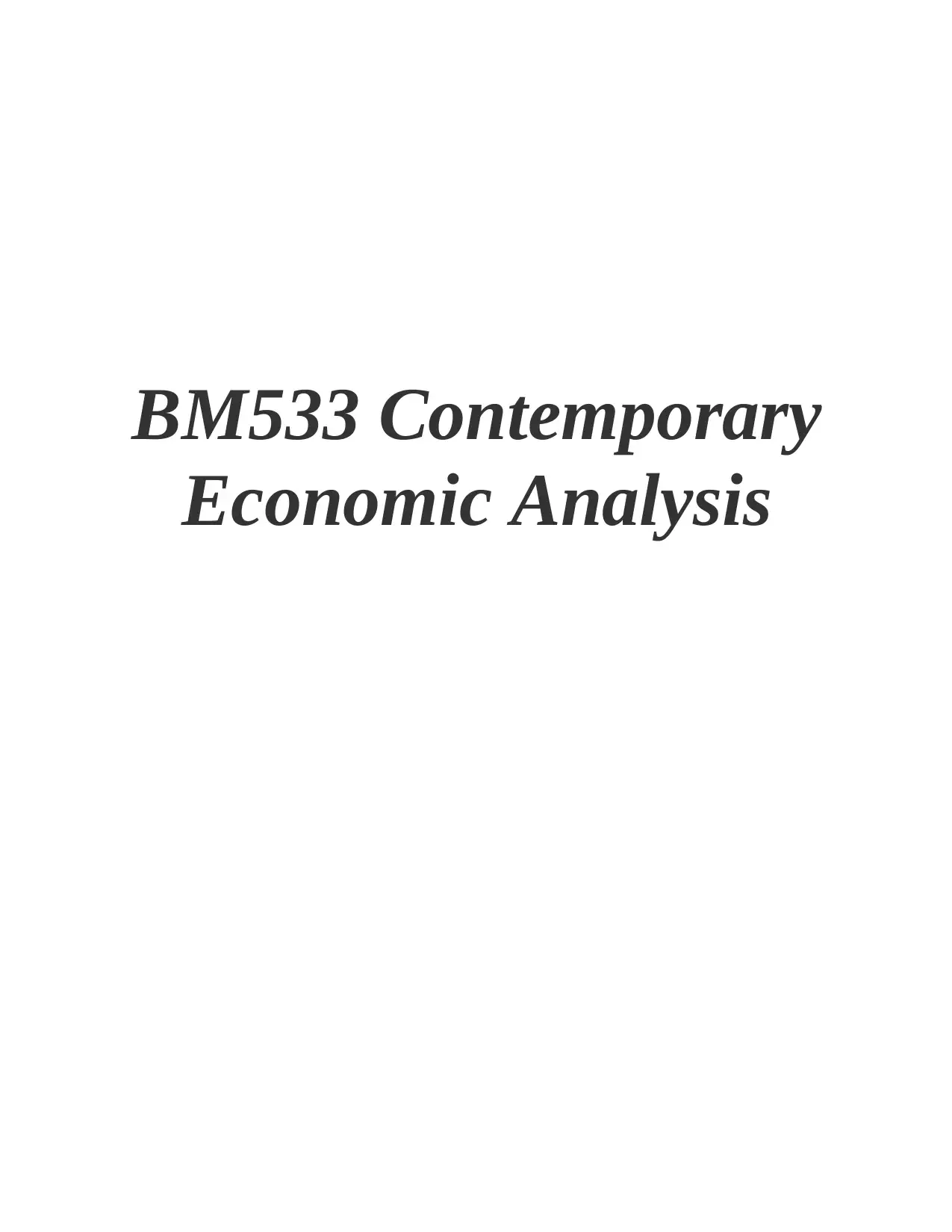
BM533 Contemporary
Economic Analysis
Economic Analysis
Paraphrase This Document
Need a fresh take? Get an instant paraphrase of this document with our AI Paraphraser
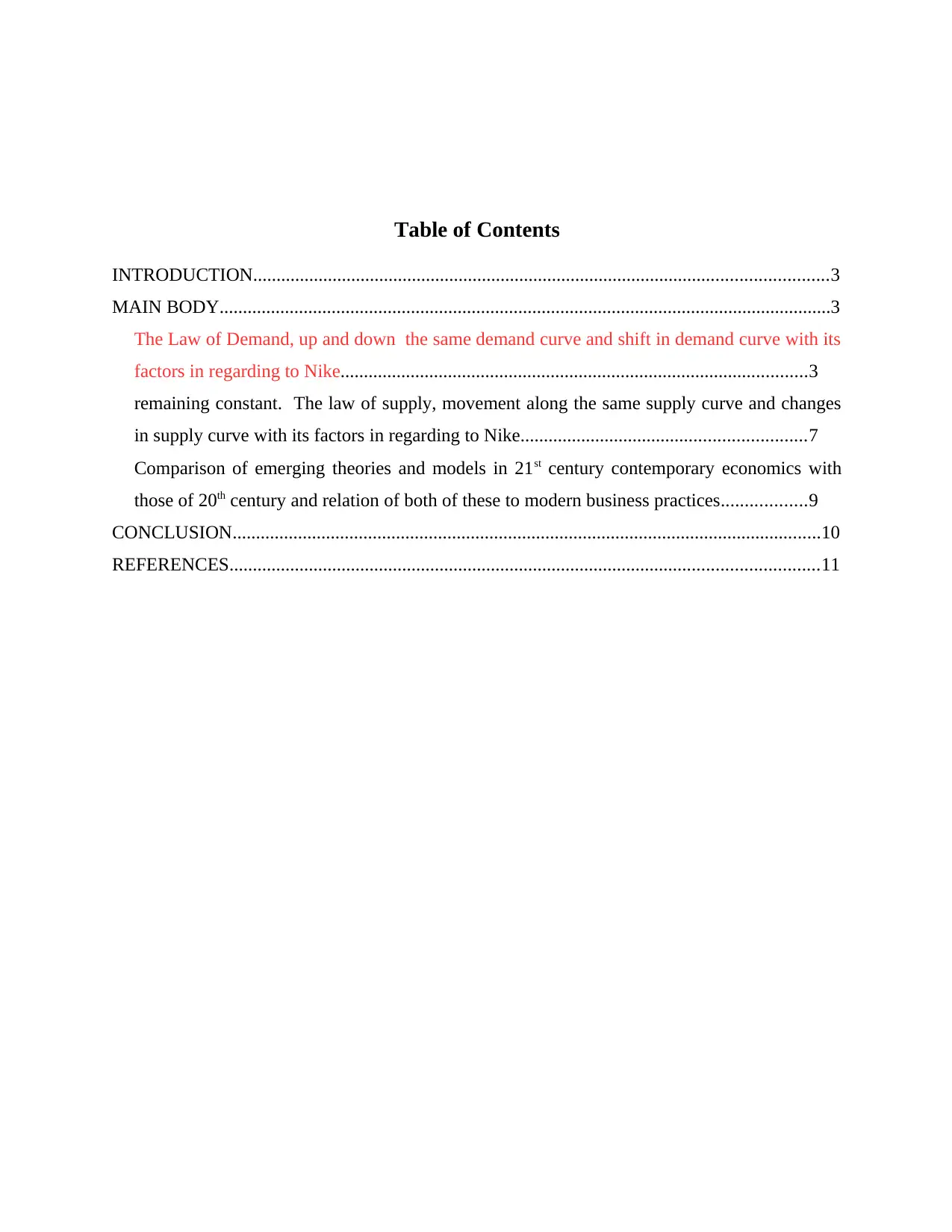
Table of Contents
INTRODUCTION...........................................................................................................................3
MAIN BODY...................................................................................................................................3
The Law of Demand, up and down the same demand curve and shift in demand curve with its
factors in regarding to Nike....................................................................................................3
remaining constant. The law of supply, movement along the same supply curve and changes
in supply curve with its factors in regarding to Nike.............................................................7
Comparison of emerging theories and models in 21st century contemporary economics with
those of 20th century and relation of both of these to modern business practices..................9
CONCLUSION..............................................................................................................................10
REFERENCES..............................................................................................................................11
INTRODUCTION...........................................................................................................................3
MAIN BODY...................................................................................................................................3
The Law of Demand, up and down the same demand curve and shift in demand curve with its
factors in regarding to Nike....................................................................................................3
remaining constant. The law of supply, movement along the same supply curve and changes
in supply curve with its factors in regarding to Nike.............................................................7
Comparison of emerging theories and models in 21st century contemporary economics with
those of 20th century and relation of both of these to modern business practices..................9
CONCLUSION..............................................................................................................................10
REFERENCES..............................................................................................................................11
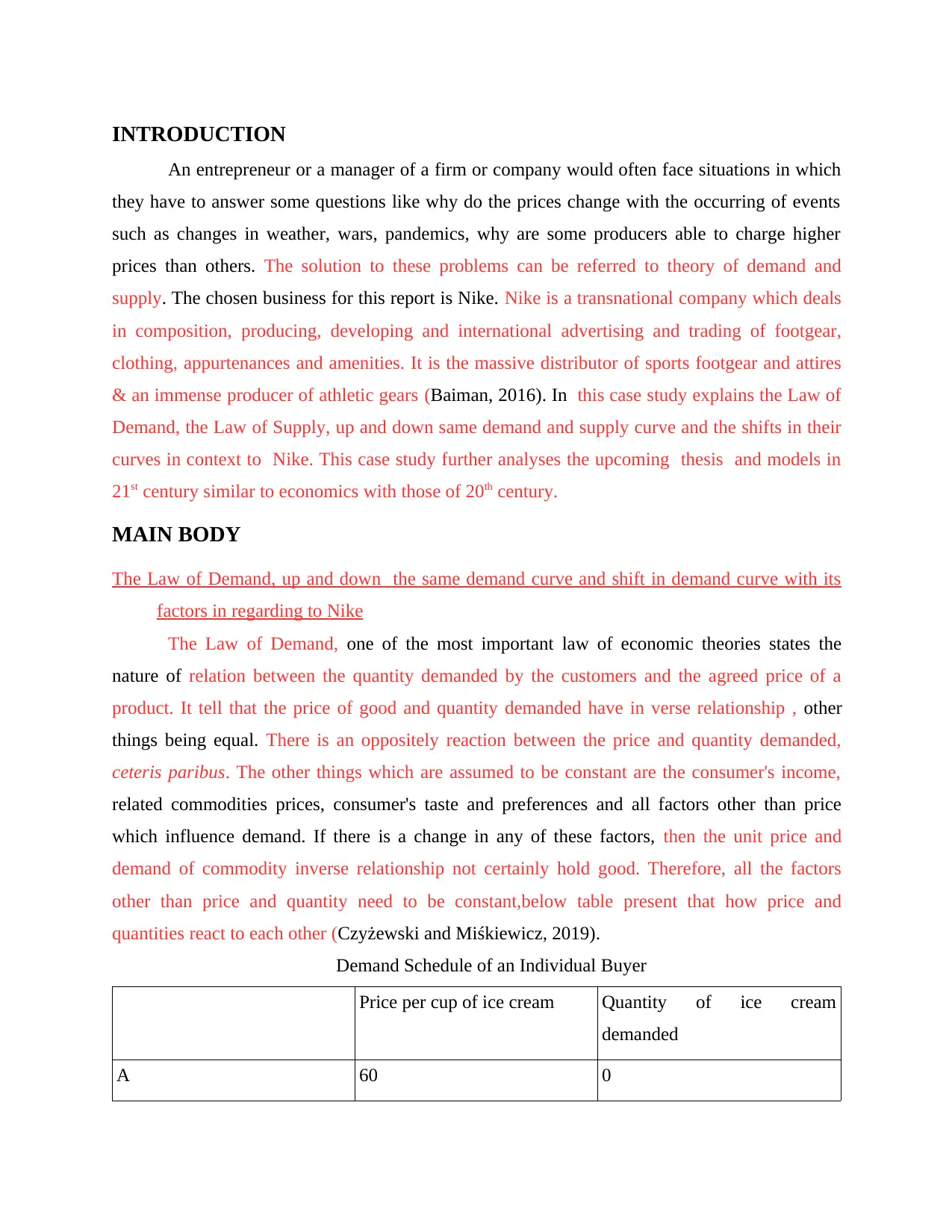
INTRODUCTION
An entrepreneur or a manager of a firm or company would often face situations in which
they have to answer some questions like why do the prices change with the occurring of events
such as changes in weather, wars, pandemics, why are some producers able to charge higher
prices than others. The solution to these problems can be referred to theory of demand and
supply. The chosen business for this report is Nike. Nike is a transnational company which deals
in composition, producing, developing and international advertising and trading of footgear,
clothing, appurtenances and amenities. It is the massive distributor of sports footgear and attires
& an immense producer of athletic gears (Baiman, 2016). In this case study explains the Law of
Demand, the Law of Supply, up and down same demand and supply curve and the shifts in their
curves in context to Nike. This case study further analyses the upcoming thesis and models in
21st century similar to economics with those of 20th century.
MAIN BODY
The Law of Demand, up and down the same demand curve and shift in demand curve with its
factors in regarding to Nike
The Law of Demand, one of the most important law of economic theories states the
nature of relation between the quantity demanded by the customers and the agreed price of a
product. It tell that the price of good and quantity demanded have in verse relationship , other
things being equal. There is an oppositely reaction between the price and quantity demanded,
ceteris paribus. The other things which are assumed to be constant are the consumer's income,
related commodities prices, consumer's taste and preferences and all factors other than price
which influence demand. If there is a change in any of these factors, then the unit price and
demand of commodity inverse relationship not certainly hold good. Therefore, all the factors
other than price and quantity need to be constant,below table present that how price and
quantities react to each other (Czyżewski and Miśkiewicz, 2019).
Demand Schedule of an Individual Buyer
Price per cup of ice cream Quantity of ice cream
demanded
A 60 0
An entrepreneur or a manager of a firm or company would often face situations in which
they have to answer some questions like why do the prices change with the occurring of events
such as changes in weather, wars, pandemics, why are some producers able to charge higher
prices than others. The solution to these problems can be referred to theory of demand and
supply. The chosen business for this report is Nike. Nike is a transnational company which deals
in composition, producing, developing and international advertising and trading of footgear,
clothing, appurtenances and amenities. It is the massive distributor of sports footgear and attires
& an immense producer of athletic gears (Baiman, 2016). In this case study explains the Law of
Demand, the Law of Supply, up and down same demand and supply curve and the shifts in their
curves in context to Nike. This case study further analyses the upcoming thesis and models in
21st century similar to economics with those of 20th century.
MAIN BODY
The Law of Demand, up and down the same demand curve and shift in demand curve with its
factors in regarding to Nike
The Law of Demand, one of the most important law of economic theories states the
nature of relation between the quantity demanded by the customers and the agreed price of a
product. It tell that the price of good and quantity demanded have in verse relationship , other
things being equal. There is an oppositely reaction between the price and quantity demanded,
ceteris paribus. The other things which are assumed to be constant are the consumer's income,
related commodities prices, consumer's taste and preferences and all factors other than price
which influence demand. If there is a change in any of these factors, then the unit price and
demand of commodity inverse relationship not certainly hold good. Therefore, all the factors
other than price and quantity need to be constant,below table present that how price and
quantities react to each other (Czyżewski and Miśkiewicz, 2019).
Demand Schedule of an Individual Buyer
Price per cup of ice cream Quantity of ice cream
demanded
A 60 0
⊘ This is a preview!⊘
Do you want full access?
Subscribe today to unlock all pages.

Trusted by 1+ million students worldwide
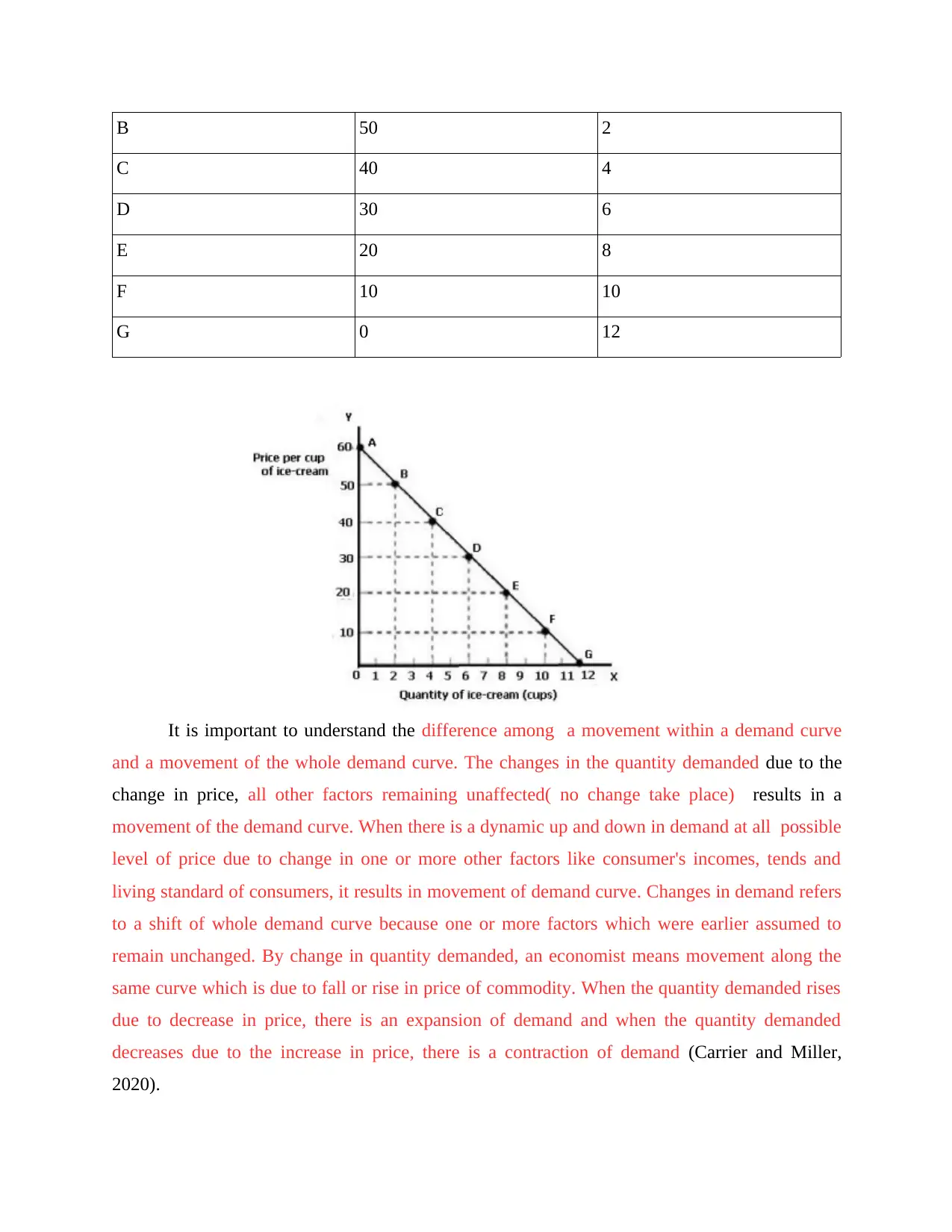
B 50 2
C 40 4
D 30 6
E 20 8
F 10 10
G 0 12
It is important to understand the difference among a movement within a demand curve
and a movement of the whole demand curve. The changes in the quantity demanded due to the
change in price, all other factors remaining unaffected( no change take place) results in a
movement of the demand curve. When there is a dynamic up and down in demand at all possible
level of price due to change in one or more other factors like consumer's incomes, tends and
living standard of consumers, it results in movement of demand curve. Changes in demand refers
to a shift of whole demand curve because one or more factors which were earlier assumed to
remain unchanged. By change in quantity demanded, an economist means movement along the
same curve which is due to fall or rise in price of commodity. When the quantity demanded rises
due to decrease in price, there is an expansion of demand and when the quantity demanded
decreases due to the increase in price, there is a contraction of demand (Carrier and Miller,
2020).
C 40 4
D 30 6
E 20 8
F 10 10
G 0 12
It is important to understand the difference among a movement within a demand curve
and a movement of the whole demand curve. The changes in the quantity demanded due to the
change in price, all other factors remaining unaffected( no change take place) results in a
movement of the demand curve. When there is a dynamic up and down in demand at all possible
level of price due to change in one or more other factors like consumer's incomes, tends and
living standard of consumers, it results in movement of demand curve. Changes in demand refers
to a shift of whole demand curve because one or more factors which were earlier assumed to
remain unchanged. By change in quantity demanded, an economist means movement along the
same curve which is due to fall or rise in price of commodity. When the quantity demanded rises
due to decrease in price, there is an expansion of demand and when the quantity demanded
decreases due to the increase in price, there is a contraction of demand (Carrier and Miller,
2020).
Paraphrase This Document
Need a fresh take? Get an instant paraphrase of this document with our AI Paraphraser
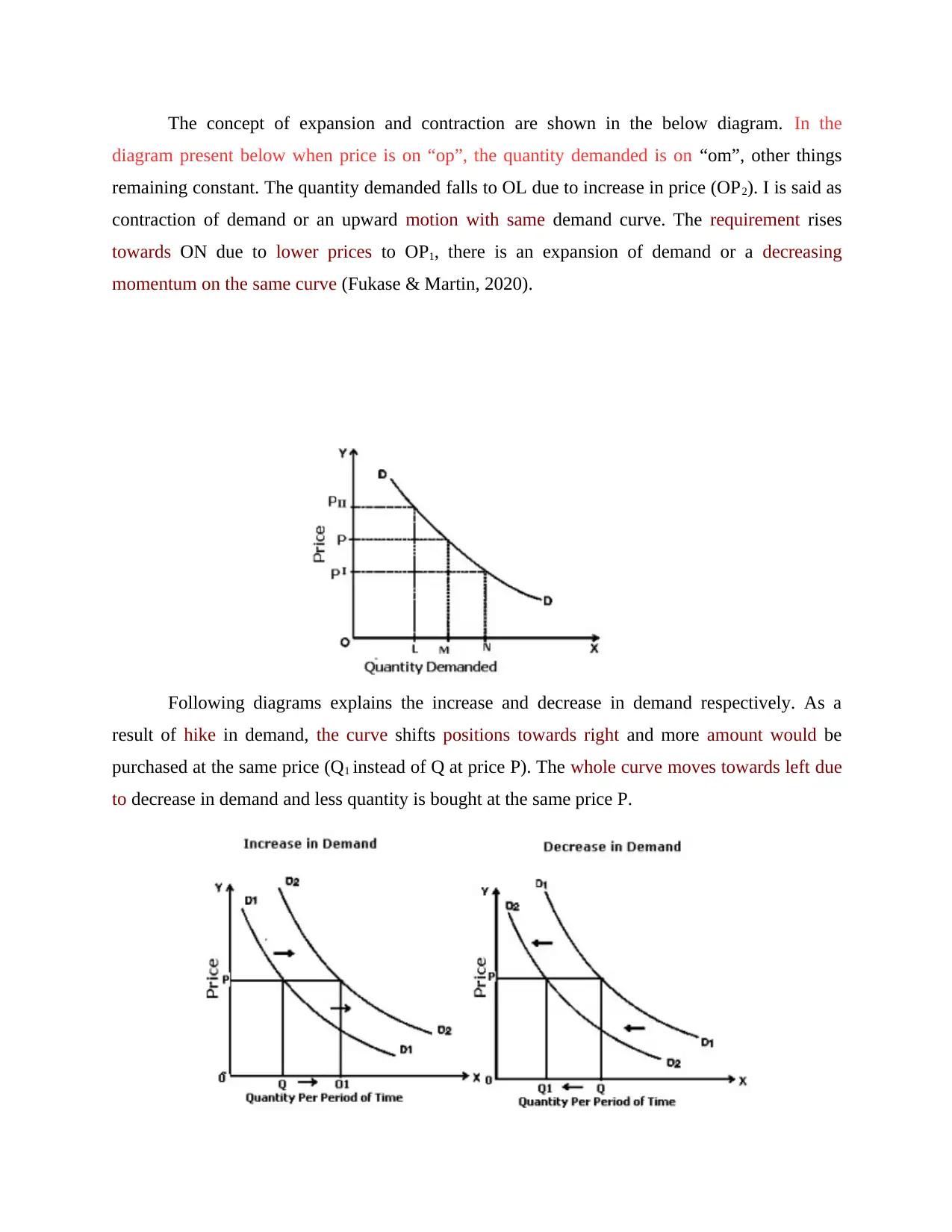
The concept of expansion and contraction are shown in the below diagram. In the
diagram present below when price is on “op”, the quantity demanded is on “om”, other things
remaining constant. The quantity demanded falls to OL due to increase in price (OP2). I is said as
contraction of demand or an upward motion with same demand curve. The requirement rises
towards ON due to lower prices to OP1, there is an expansion of demand or a decreasing
momentum on the same curve (Fukase & Martin, 2020).
Following diagrams explains the increase and decrease in demand respectively. As a
result of hike in demand, the curve shifts positions towards right and more amount would be
purchased at the same price (Q1 instead of Q at price P). The whole curve moves towards left due
to decrease in demand and less quantity is bought at the same price P.
diagram present below when price is on “op”, the quantity demanded is on “om”, other things
remaining constant. The quantity demanded falls to OL due to increase in price (OP2). I is said as
contraction of demand or an upward motion with same demand curve. The requirement rises
towards ON due to lower prices to OP1, there is an expansion of demand or a decreasing
momentum on the same curve (Fukase & Martin, 2020).
Following diagrams explains the increase and decrease in demand respectively. As a
result of hike in demand, the curve shifts positions towards right and more amount would be
purchased at the same price (Q1 instead of Q at price P). The whole curve moves towards left due
to decrease in demand and less quantity is bought at the same price P.
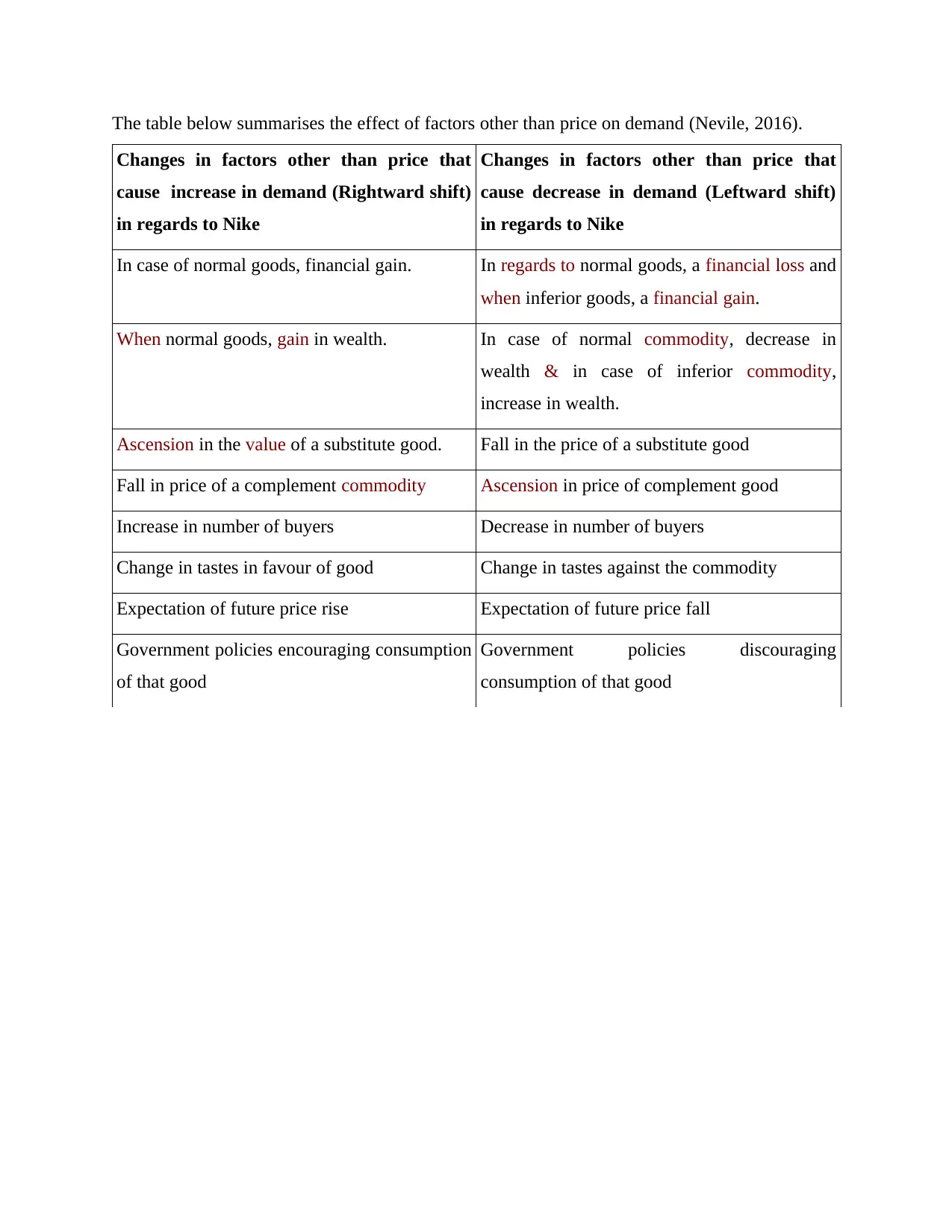
The table below summarises the effect of factors other than price on demand (Nevile, 2016).
Changes in factors other than price that
cause increase in demand (Rightward shift)
in regards to Nike
Changes in factors other than price that
cause decrease in demand (Leftward shift)
in regards to Nike
In case of normal goods, financial gain. In regards to normal goods, a financial loss and
when inferior goods, a financial gain.
When normal goods, gain in wealth. In case of normal commodity, decrease in
wealth & in case of inferior commodity,
increase in wealth.
Ascension in the value of a substitute good. Fall in the price of a substitute good
Fall in price of a complement commodity Ascension in price of complement good
Increase in number of buyers Decrease in number of buyers
Change in tastes in favour of good Change in tastes against the commodity
Expectation of future price rise Expectation of future price fall
Government policies encouraging consumption
of that good
Government policies discouraging
consumption of that good
Changes in factors other than price that
cause increase in demand (Rightward shift)
in regards to Nike
Changes in factors other than price that
cause decrease in demand (Leftward shift)
in regards to Nike
In case of normal goods, financial gain. In regards to normal goods, a financial loss and
when inferior goods, a financial gain.
When normal goods, gain in wealth. In case of normal commodity, decrease in
wealth & in case of inferior commodity,
increase in wealth.
Ascension in the value of a substitute good. Fall in the price of a substitute good
Fall in price of a complement commodity Ascension in price of complement good
Increase in number of buyers Decrease in number of buyers
Change in tastes in favour of good Change in tastes against the commodity
Expectation of future price rise Expectation of future price fall
Government policies encouraging consumption
of that good
Government policies discouraging
consumption of that good
⊘ This is a preview!⊘
Do you want full access?
Subscribe today to unlock all pages.

Trusted by 1+ million students worldwide
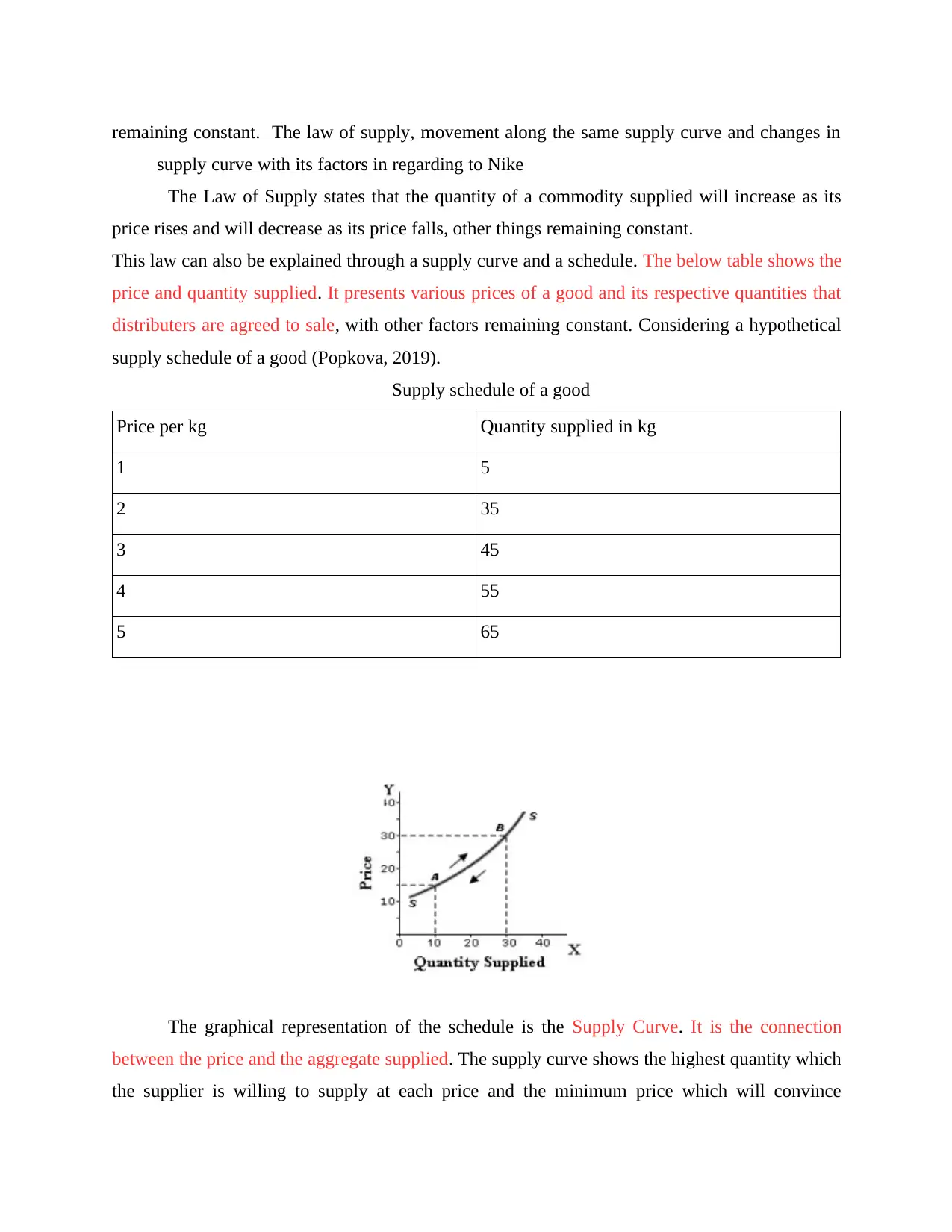
remaining constant. The law of supply, movement along the same supply curve and changes in
supply curve with its factors in regarding to Nike
The Law of Supply states that the quantity of a commodity supplied will increase as its
price rises and will decrease as its price falls, other things remaining constant.
This law can also be explained through a supply curve and a schedule. The below table shows the
price and quantity supplied. It presents various prices of a good and its respective quantities that
distributers are agreed to sale, with other factors remaining constant. Considering a hypothetical
supply schedule of a good (Popkova, 2019).
Supply schedule of a good
Price per kg Quantity supplied in kg
1 5
2 35
3 45
4 55
5 65
The graphical representation of the schedule is the Supply Curve. It is the connection
between the price and the aggregate supplied. The supply curve shows the highest quantity which
the supplier is willing to supply at each price and the minimum price which will convince
supply curve with its factors in regarding to Nike
The Law of Supply states that the quantity of a commodity supplied will increase as its
price rises and will decrease as its price falls, other things remaining constant.
This law can also be explained through a supply curve and a schedule. The below table shows the
price and quantity supplied. It presents various prices of a good and its respective quantities that
distributers are agreed to sale, with other factors remaining constant. Considering a hypothetical
supply schedule of a good (Popkova, 2019).
Supply schedule of a good
Price per kg Quantity supplied in kg
1 5
2 35
3 45
4 55
5 65
The graphical representation of the schedule is the Supply Curve. It is the connection
between the price and the aggregate supplied. The supply curve shows the highest quantity which
the supplier is willing to supply at each price and the minimum price which will convince
Paraphrase This Document
Need a fresh take? Get an instant paraphrase of this document with our AI Paraphraser
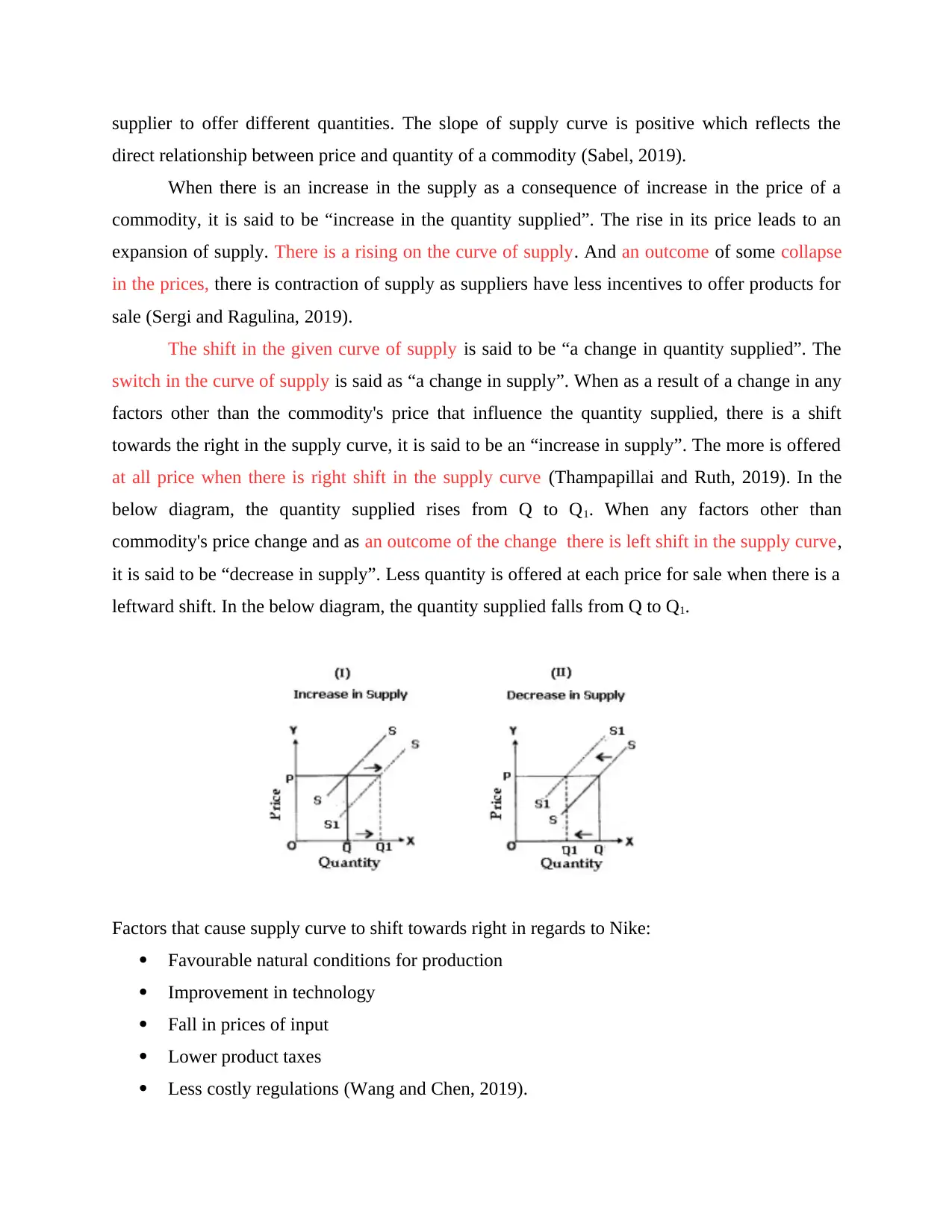
supplier to offer different quantities. The slope of supply curve is positive which reflects the
direct relationship between price and quantity of a commodity (Sabel, 2019).
When there is an increase in the supply as a consequence of increase in the price of a
commodity, it is said to be “increase in the quantity supplied”. The rise in its price leads to an
expansion of supply. There is a rising on the curve of supply. And an outcome of some collapse
in the prices, there is contraction of supply as suppliers have less incentives to offer products for
sale (Sergi and Ragulina, 2019).
The shift in the given curve of supply is said to be “a change in quantity supplied”. The
switch in the curve of supply is said as “a change in supply”. When as a result of a change in any
factors other than the commodity's price that influence the quantity supplied, there is a shift
towards the right in the supply curve, it is said to be an “increase in supply”. The more is offered
at all price when there is right shift in the supply curve (Thampapillai and Ruth, 2019). In the
below diagram, the quantity supplied rises from Q to Q1. When any factors other than
commodity's price change and as an outcome of the change there is left shift in the supply curve,
it is said to be “decrease in supply”. Less quantity is offered at each price for sale when there is a
leftward shift. In the below diagram, the quantity supplied falls from Q to Q1.
Factors that cause supply curve to shift towards right in regards to Nike:
Favourable natural conditions for production
Improvement in technology
Fall in prices of input
Lower product taxes
Less costly regulations (Wang and Chen, 2019).
direct relationship between price and quantity of a commodity (Sabel, 2019).
When there is an increase in the supply as a consequence of increase in the price of a
commodity, it is said to be “increase in the quantity supplied”. The rise in its price leads to an
expansion of supply. There is a rising on the curve of supply. And an outcome of some collapse
in the prices, there is contraction of supply as suppliers have less incentives to offer products for
sale (Sergi and Ragulina, 2019).
The shift in the given curve of supply is said to be “a change in quantity supplied”. The
switch in the curve of supply is said as “a change in supply”. When as a result of a change in any
factors other than the commodity's price that influence the quantity supplied, there is a shift
towards the right in the supply curve, it is said to be an “increase in supply”. The more is offered
at all price when there is right shift in the supply curve (Thampapillai and Ruth, 2019). In the
below diagram, the quantity supplied rises from Q to Q1. When any factors other than
commodity's price change and as an outcome of the change there is left shift in the supply curve,
it is said to be “decrease in supply”. Less quantity is offered at each price for sale when there is a
leftward shift. In the below diagram, the quantity supplied falls from Q to Q1.
Factors that cause supply curve to shift towards right in regards to Nike:
Favourable natural conditions for production
Improvement in technology
Fall in prices of input
Lower product taxes
Less costly regulations (Wang and Chen, 2019).
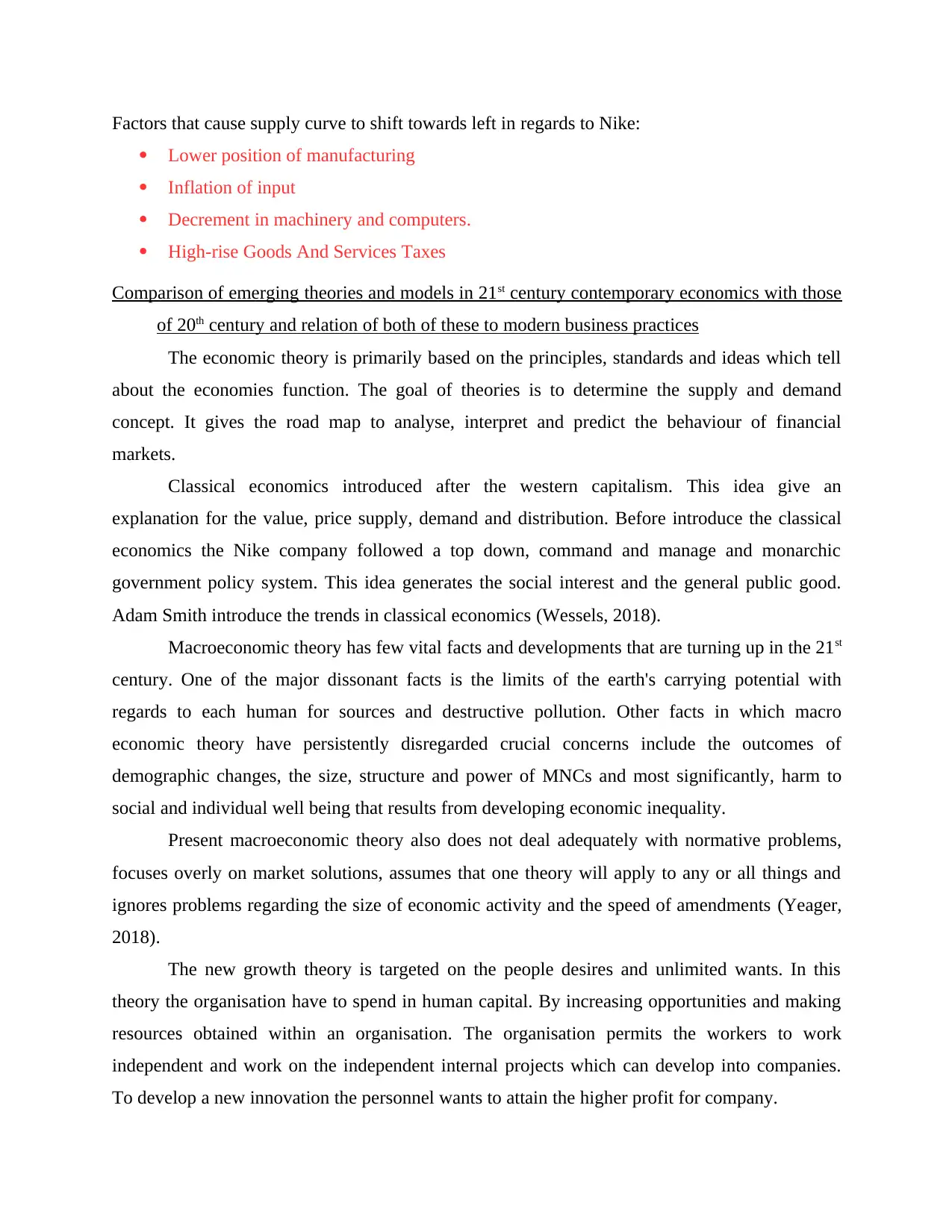
Factors that cause supply curve to shift towards left in regards to Nike:
Lower position of manufacturing
Inflation of input
Decrement in machinery and computers.
High-rise Goods And Services Taxes
Comparison of emerging theories and models in 21st century contemporary economics with those
of 20th century and relation of both of these to modern business practices
The economic theory is primarily based on the principles, standards and ideas which tell
about the economies function. The goal of theories is to determine the supply and demand
concept. It gives the road map to analyse, interpret and predict the behaviour of financial
markets.
Classical economics introduced after the western capitalism. This idea give an
explanation for the value, price supply, demand and distribution. Before introduce the classical
economics the Nike company followed a top down, command and manage and monarchic
government policy system. This idea generates the social interest and the general public good.
Adam Smith introduce the trends in classical economics (Wessels, 2018).
Macroeconomic theory has few vital facts and developments that are turning up in the 21st
century. One of the major dissonant facts is the limits of the earth's carrying potential with
regards to each human for sources and destructive pollution. Other facts in which macro
economic theory have persistently disregarded crucial concerns include the outcomes of
demographic changes, the size, structure and power of MNCs and most significantly, harm to
social and individual well being that results from developing economic inequality.
Present macroeconomic theory also does not deal adequately with normative problems,
focuses overly on market solutions, assumes that one theory will apply to any or all things and
ignores problems regarding the size of economic activity and the speed of amendments (Yeager,
2018).
The new growth theory is targeted on the people desires and unlimited wants. In this
theory the organisation have to spend in human capital. By increasing opportunities and making
resources obtained within an organisation. The organisation permits the workers to work
independent and work on the independent internal projects which can develop into companies.
To develop a new innovation the personnel wants to attain the higher profit for company.
Lower position of manufacturing
Inflation of input
Decrement in machinery and computers.
High-rise Goods And Services Taxes
Comparison of emerging theories and models in 21st century contemporary economics with those
of 20th century and relation of both of these to modern business practices
The economic theory is primarily based on the principles, standards and ideas which tell
about the economies function. The goal of theories is to determine the supply and demand
concept. It gives the road map to analyse, interpret and predict the behaviour of financial
markets.
Classical economics introduced after the western capitalism. This idea give an
explanation for the value, price supply, demand and distribution. Before introduce the classical
economics the Nike company followed a top down, command and manage and monarchic
government policy system. This idea generates the social interest and the general public good.
Adam Smith introduce the trends in classical economics (Wessels, 2018).
Macroeconomic theory has few vital facts and developments that are turning up in the 21st
century. One of the major dissonant facts is the limits of the earth's carrying potential with
regards to each human for sources and destructive pollution. Other facts in which macro
economic theory have persistently disregarded crucial concerns include the outcomes of
demographic changes, the size, structure and power of MNCs and most significantly, harm to
social and individual well being that results from developing economic inequality.
Present macroeconomic theory also does not deal adequately with normative problems,
focuses overly on market solutions, assumes that one theory will apply to any or all things and
ignores problems regarding the size of economic activity and the speed of amendments (Yeager,
2018).
The new growth theory is targeted on the people desires and unlimited wants. In this
theory the organisation have to spend in human capital. By increasing opportunities and making
resources obtained within an organisation. The organisation permits the workers to work
independent and work on the independent internal projects which can develop into companies.
To develop a new innovation the personnel wants to attain the higher profit for company.
⊘ This is a preview!⊘
Do you want full access?
Subscribe today to unlock all pages.

Trusted by 1+ million students worldwide
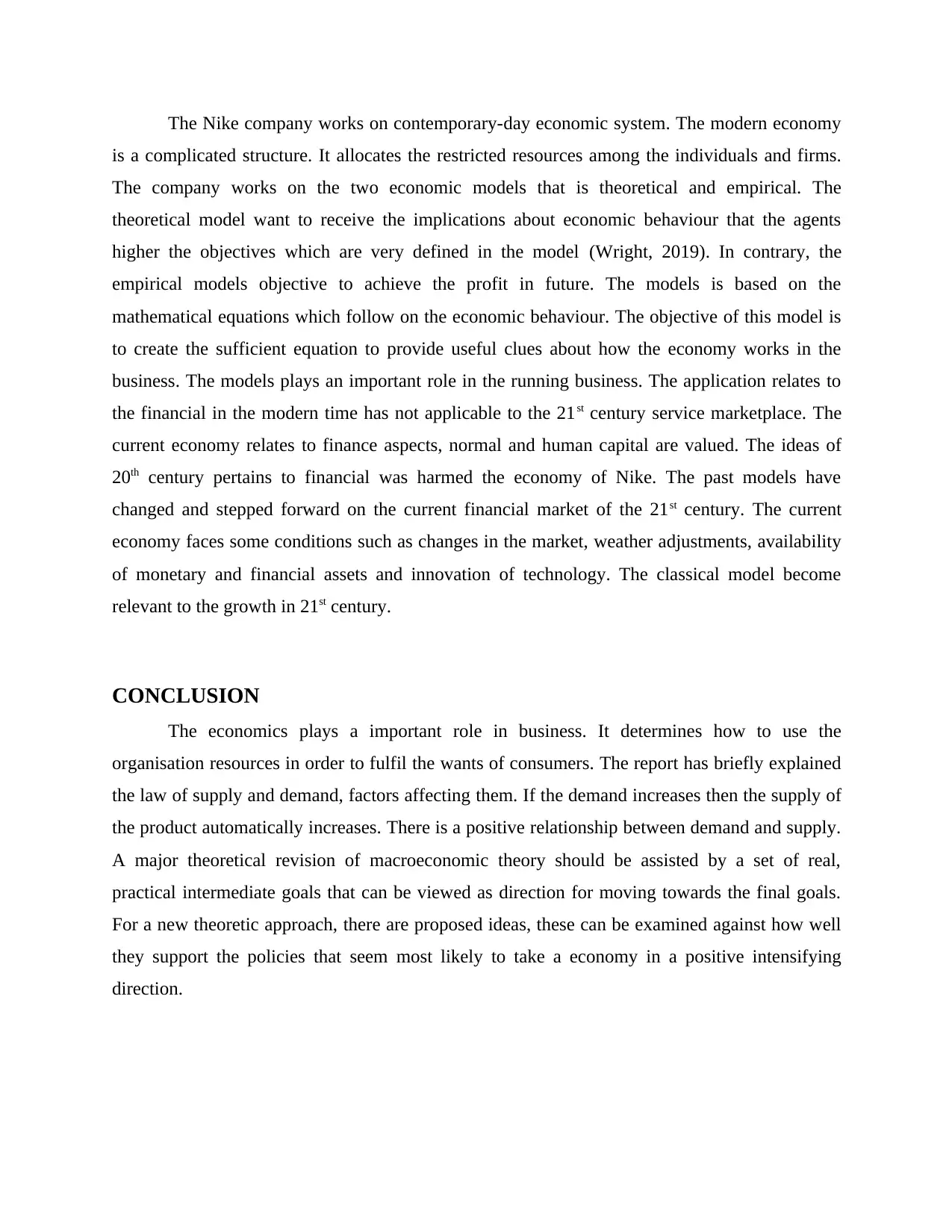
The Nike company works on contemporary-day economic system. The modern economy
is a complicated structure. It allocates the restricted resources among the individuals and firms.
The company works on the two economic models that is theoretical and empirical. The
theoretical model want to receive the implications about economic behaviour that the agents
higher the objectives which are very defined in the model (Wright, 2019). In contrary, the
empirical models objective to achieve the profit in future. The models is based on the
mathematical equations which follow on the economic behaviour. The objective of this model is
to create the sufficient equation to provide useful clues about how the economy works in the
business. The models plays an important role in the running business. The application relates to
the financial in the modern time has not applicable to the 21st century service marketplace. The
current economy relates to finance aspects, normal and human capital are valued. The ideas of
20th century pertains to financial was harmed the economy of Nike. The past models have
changed and stepped forward on the current financial market of the 21st century. The current
economy faces some conditions such as changes in the market, weather adjustments, availability
of monetary and financial assets and innovation of technology. The classical model become
relevant to the growth in 21st century.
CONCLUSION
The economics plays a important role in business. It determines how to use the
organisation resources in order to fulfil the wants of consumers. The report has briefly explained
the law of supply and demand, factors affecting them. If the demand increases then the supply of
the product automatically increases. There is a positive relationship between demand and supply.
A major theoretical revision of macroeconomic theory should be assisted by a set of real,
practical intermediate goals that can be viewed as direction for moving towards the final goals.
For a new theoretic approach, there are proposed ideas, these can be examined against how well
they support the policies that seem most likely to take a economy in a positive intensifying
direction.
is a complicated structure. It allocates the restricted resources among the individuals and firms.
The company works on the two economic models that is theoretical and empirical. The
theoretical model want to receive the implications about economic behaviour that the agents
higher the objectives which are very defined in the model (Wright, 2019). In contrary, the
empirical models objective to achieve the profit in future. The models is based on the
mathematical equations which follow on the economic behaviour. The objective of this model is
to create the sufficient equation to provide useful clues about how the economy works in the
business. The models plays an important role in the running business. The application relates to
the financial in the modern time has not applicable to the 21st century service marketplace. The
current economy relates to finance aspects, normal and human capital are valued. The ideas of
20th century pertains to financial was harmed the economy of Nike. The past models have
changed and stepped forward on the current financial market of the 21st century. The current
economy faces some conditions such as changes in the market, weather adjustments, availability
of monetary and financial assets and innovation of technology. The classical model become
relevant to the growth in 21st century.
CONCLUSION
The economics plays a important role in business. It determines how to use the
organisation resources in order to fulfil the wants of consumers. The report has briefly explained
the law of supply and demand, factors affecting them. If the demand increases then the supply of
the product automatically increases. There is a positive relationship between demand and supply.
A major theoretical revision of macroeconomic theory should be assisted by a set of real,
practical intermediate goals that can be viewed as direction for moving towards the final goals.
For a new theoretic approach, there are proposed ideas, these can be examined against how well
they support the policies that seem most likely to take a economy in a positive intensifying
direction.
Paraphrase This Document
Need a fresh take? Get an instant paraphrase of this document with our AI Paraphraser
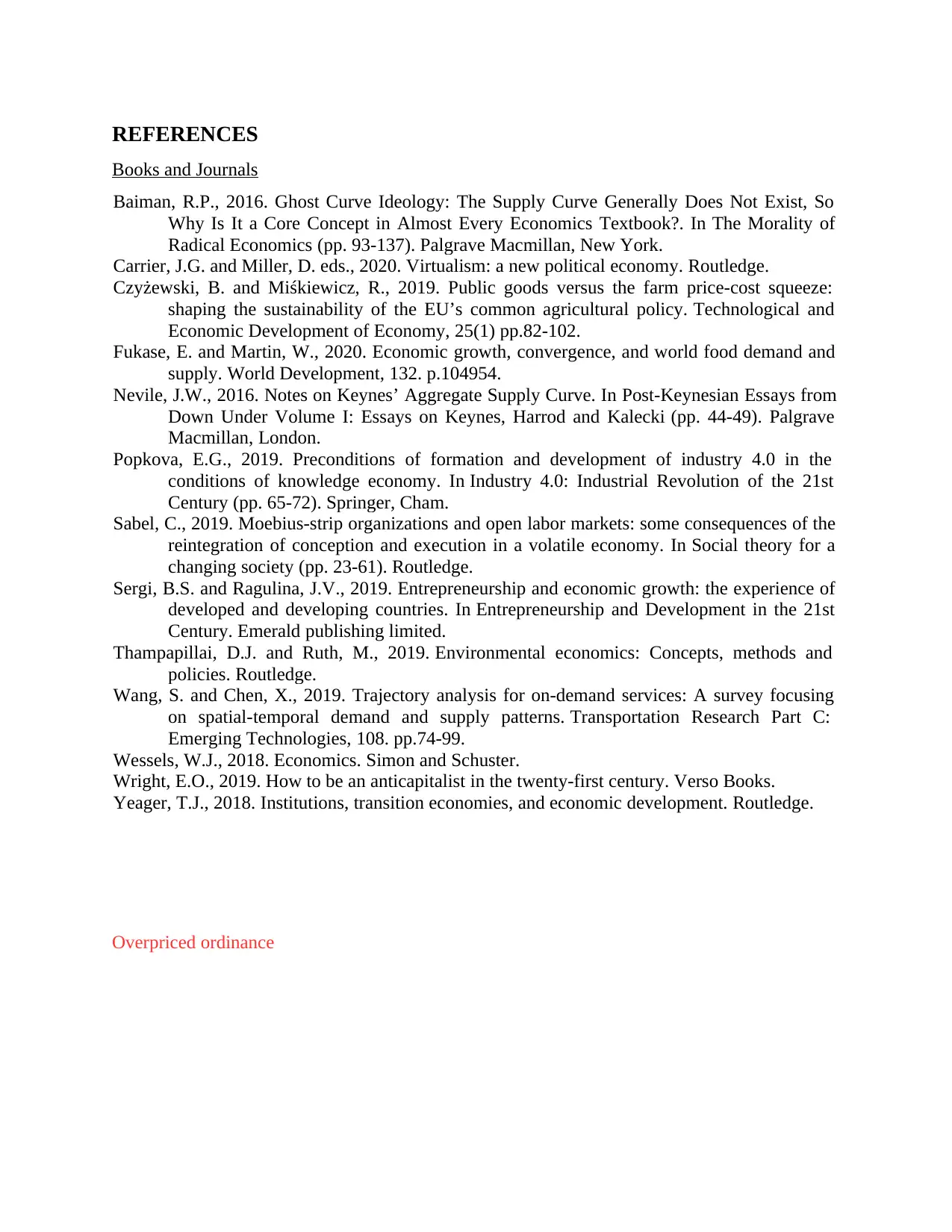
REFERENCES
Books and Journals
Baiman, R.P., 2016. Ghost Curve Ideology: The Supply Curve Generally Does Not Exist, So
Why Is It a Core Concept in Almost Every Economics Textbook?. In The Morality of
Radical Economics (pp. 93-137). Palgrave Macmillan, New York.
Carrier, J.G. and Miller, D. eds., 2020. Virtualism: a new political economy. Routledge.
Czyżewski, B. and Miśkiewicz, R., 2019. Public goods versus the farm price-cost squeeze:
shaping the sustainability of the EU’s common agricultural policy. Technological and
Economic Development of Economy, 25(1) pp.82-102.
Fukase, E. and Martin, W., 2020. Economic growth, convergence, and world food demand and
supply. World Development, 132. p.104954.
Nevile, J.W., 2016. Notes on Keynes’ Aggregate Supply Curve. In Post-Keynesian Essays from
Down Under Volume I: Essays on Keynes, Harrod and Kalecki (pp. 44-49). Palgrave
Macmillan, London.
Popkova, E.G., 2019. Preconditions of formation and development of industry 4.0 in the
conditions of knowledge economy. In Industry 4.0: Industrial Revolution of the 21st
Century (pp. 65-72). Springer, Cham.
Sabel, C., 2019. Moebius-strip organizations and open labor markets: some consequences of the
reintegration of conception and execution in a volatile economy. In Social theory for a
changing society (pp. 23-61). Routledge.
Sergi, B.S. and Ragulina, J.V., 2019. Entrepreneurship and economic growth: the experience of
developed and developing countries. In Entrepreneurship and Development in the 21st
Century. Emerald publishing limited.
Thampapillai, D.J. and Ruth, M., 2019. Environmental economics: Concepts, methods and
policies. Routledge.
Wang, S. and Chen, X., 2019. Trajectory analysis for on-demand services: A survey focusing
on spatial-temporal demand and supply patterns. Transportation Research Part C:
Emerging Technologies, 108. pp.74-99.
Wessels, W.J., 2018. Economics. Simon and Schuster.
Wright, E.O., 2019. How to be an anticapitalist in the twenty-first century. Verso Books.
Yeager, T.J., 2018. Institutions, transition economies, and economic development. Routledge.
Overpriced ordinance
Books and Journals
Baiman, R.P., 2016. Ghost Curve Ideology: The Supply Curve Generally Does Not Exist, So
Why Is It a Core Concept in Almost Every Economics Textbook?. In The Morality of
Radical Economics (pp. 93-137). Palgrave Macmillan, New York.
Carrier, J.G. and Miller, D. eds., 2020. Virtualism: a new political economy. Routledge.
Czyżewski, B. and Miśkiewicz, R., 2019. Public goods versus the farm price-cost squeeze:
shaping the sustainability of the EU’s common agricultural policy. Technological and
Economic Development of Economy, 25(1) pp.82-102.
Fukase, E. and Martin, W., 2020. Economic growth, convergence, and world food demand and
supply. World Development, 132. p.104954.
Nevile, J.W., 2016. Notes on Keynes’ Aggregate Supply Curve. In Post-Keynesian Essays from
Down Under Volume I: Essays on Keynes, Harrod and Kalecki (pp. 44-49). Palgrave
Macmillan, London.
Popkova, E.G., 2019. Preconditions of formation and development of industry 4.0 in the
conditions of knowledge economy. In Industry 4.0: Industrial Revolution of the 21st
Century (pp. 65-72). Springer, Cham.
Sabel, C., 2019. Moebius-strip organizations and open labor markets: some consequences of the
reintegration of conception and execution in a volatile economy. In Social theory for a
changing society (pp. 23-61). Routledge.
Sergi, B.S. and Ragulina, J.V., 2019. Entrepreneurship and economic growth: the experience of
developed and developing countries. In Entrepreneurship and Development in the 21st
Century. Emerald publishing limited.
Thampapillai, D.J. and Ruth, M., 2019. Environmental economics: Concepts, methods and
policies. Routledge.
Wang, S. and Chen, X., 2019. Trajectory analysis for on-demand services: A survey focusing
on spatial-temporal demand and supply patterns. Transportation Research Part C:
Emerging Technologies, 108. pp.74-99.
Wessels, W.J., 2018. Economics. Simon and Schuster.
Wright, E.O., 2019. How to be an anticapitalist in the twenty-first century. Verso Books.
Yeager, T.J., 2018. Institutions, transition economies, and economic development. Routledge.
Overpriced ordinance
1 out of 11
Related Documents
Your All-in-One AI-Powered Toolkit for Academic Success.
+13062052269
info@desklib.com
Available 24*7 on WhatsApp / Email
![[object Object]](/_next/static/media/star-bottom.7253800d.svg)
Unlock your academic potential
Copyright © 2020–2025 A2Z Services. All Rights Reserved. Developed and managed by ZUCOL.




